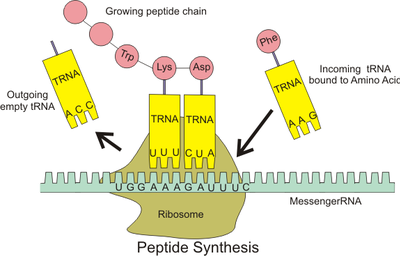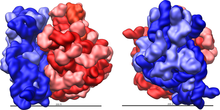Ribosomes
Ribosomes assemble polypeptides from amino acids on molecules of transfer RNA (tRNA) in a sequence specified by mRNA.
A functional ribosome has two subunits of different sizes bound to a strand of mRNA. The core of the small ribosomal subunit is a highly folded ribosomal RNA (rRNA) chain associated with more than 30 unique proteins; the core of the large subunit has three other rRNA molecules and nearly 50 other basic proteins.
The rRNA molecules in the ribosomal subunits not only provide structural support but also position transfer RNAs (tRNA) molecules bearing amino acids in the correct “reading frame” and catalyze the formation of the peptide bonds. The more peripheral proteins of the ribosome seem to function primarily to stabilize the catalytic RNA core.
These ribosomal proteins are themselves synthesized in cytoplasmic ribosomes, but are then imported to the nucleus where they associate with newly synthesized rRNA. The ribosomal subunits thus formed then move from the nucleus to the cytoplasm where they are reused many times, for translation of any mRNA strand.
During protein synthesis many ribosomes typically bind the same strand of mRNA to form larger complexes, called polyribosomes or polysomes (Figure 2–9). In stained preparations of cells, polyribosomes are intensely basophilic because of the numerous phosphate groups of the constituent RNA molecules that act as polyanions. Thus, cytoplasmic regions that stain intensely with hematoxylin and basic dyes, such as methylene and toluidine blue, indicate sites of active protein synthesis.
A ribosome is a mixture of protein and RNA that starts its formation in the nucleolus of a cell.
Ribosome structure
Ribosomes are made out of two things: a small ribosomal subunit that reads the mRNA, while the large subunit joins amino acids to form a polypeptide chain. Each subunit is composed of one or more ribosomal RNA (rRNA) molecules and a variety of proteins.
Eukaryotes have 80S ribosomes, each consisting of a small (40S) and large (60S) subunit.[1][2][3] Their small subunit has a 16S RNA sub-unit (consisting of 1540 nucleotides) bound to 21 proteins. The large subunit has a 5S RNA (120 nucleotides), a 28S RNA (4700 nucleotides), a 5.8S RNA (160 nucleotides) subunits and 46 proteins.[2][4][5]
Ribosomes make new proteins. It does this by moving along a strand of RNA and building a protein based on the code it reads. Making a protein this way is called translation, building proteins from amino acids using messenger RNA as a template.

Ribosomes are usually found in the rough endoplasmic reticulum, but can also be found throughout the cytoplasm.

Ribosomes read the sequence of messenger RNAs and assemble proteins out of amino acids bound to transfer RNAs.
+++++++++++++++++
Ribosomes found in the cytosol are composed of four segments of rRNA and approximately 80 different proteins. Ribosomes are about 20 × 30 nm in size.
Bound to mRNA, all ribosomes have two subunits of different sizes and act to catalyze the process of protein translation.
In eukaryotic cells, the rRNA molecules of both subunits are synthesized within the nucleus. Their numerous proteins are synthesized in the cytoplasm but then enter the nucleus and associate with rRNAs. The assembled large and small subunits then leave the nucleus and enter the cytoplasm to participate in protein synthesis.
The large and small ribosomal subunits come together by binding an mRNA strand and typically many ribosomes occupy a single mRNA to form polyribosomes (or polysomes). With the nucleotide sequence of the mRNA specifying the polypeptide sequence being synthesized, ribosomes assemble the protein chain from amino acids ferried in by tRNA. The compact core of each ribosome contains the rRNA molecules that not only provide structural support but also position tRNAs in the correct "reading frame" and catalyze the formation of the peptide bonds.
The more peripheral proteins of the ribosome seem to function primarily to stabilize the catalytic RNA core.
